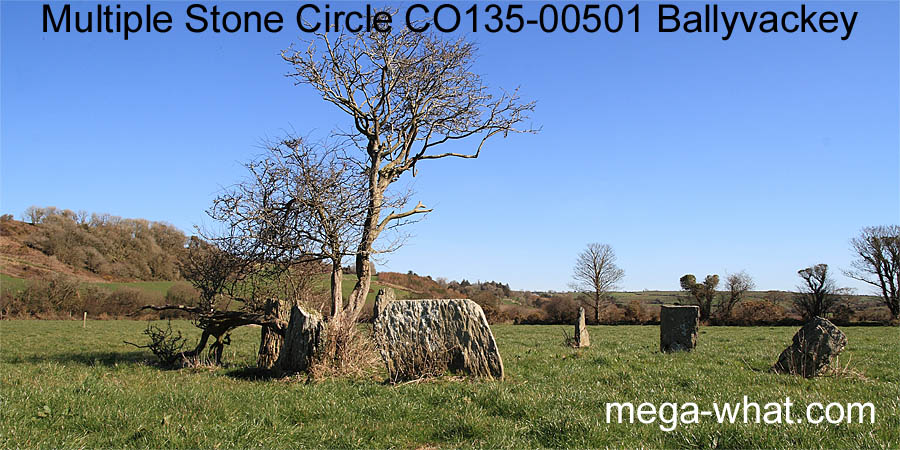 Ballyvackey Stone Circle & Boulder-Burial are a short distance from the R599, about 4km ENE of Clonakilty in West Cork.
The circle is about 8.5m diameter with seven stones remaining out of a probable nine. One of them is a radially set portal.
Ballyvackey Stone Circle & Boulder-Burial are a short distance from the R599, about 4km ENE of Clonakilty in West Cork.
The circle is about 8.5m diameter with seven stones remaining out of a probable nine. One of them is a radially set portal.
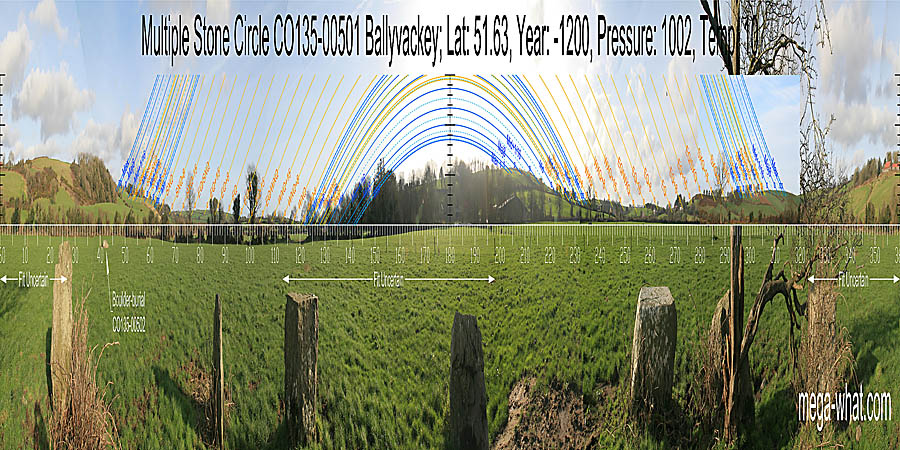 North is indicated by a hilltop notch from the Circle and also from the Boulder.
North is indicated by a hilltop notch from the Circle and also from the Boulder.
South is indicated by the secondary top of a hill from the Circle and again from the Boulder.
To both sides, the south lunisticeLunistices are the most northerly and southerly moons of the month. The lunar equivalent of solstices - more. zone runs down slope and turns in the basal dip. There follows a rise, dip, rise, dip sequence. The north-east lunistice zone runs up a slope with summer solstice sunrise just before / at a significant step. The north-west lunistice zone spans a hill with summer solstice sunset just before / at the top.
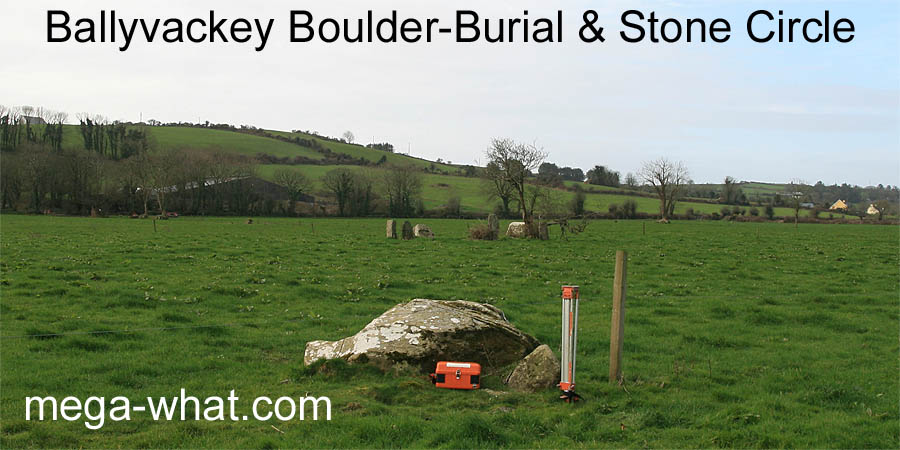 The Boulder-Burial and half-metre high Standing Stone are right beside each other, about 50m north-east of the circle.
The Boulder-Burial and half-metre high Standing Stone are right beside each other, about 50m north-east of the circle.
Small uprights accompany a number of other Boulder-Burials and "Megalithic Structures". This one is only notable for being accorded an individual listing. Ó'Nualláin (1984:24) was doubtful whether this really was a Boulder-Burial but that was before the excavation at Cooradarrigan proved that their coverstones were not always clear of the ground. This probably is a Boulder-Burial as there are discernable astronomical advantages to the site though of course it could be a large boulder dumped beside a very small Standing Stone that was an original outlier of the circle. A similar Boulder-Burial / Multiple Stone Circle relationship may be found at Bohonagh.
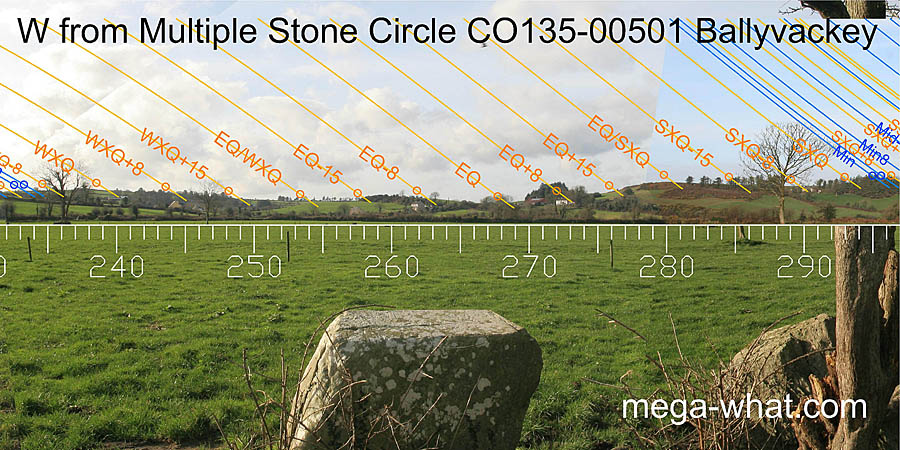 The western axis of the circle [closeup] indicates a low hill in the valley floor.
The equinox is in the dip between this hill and the northern valley side while the hill itself makes an effective marker for the half-month south of the equinox.
The western axis of the circle [closeup] indicates a low hill in the valley floor.
The equinox is in the dip between this hill and the northern valley side while the hill itself makes an effective marker for the half-month south of the equinox.
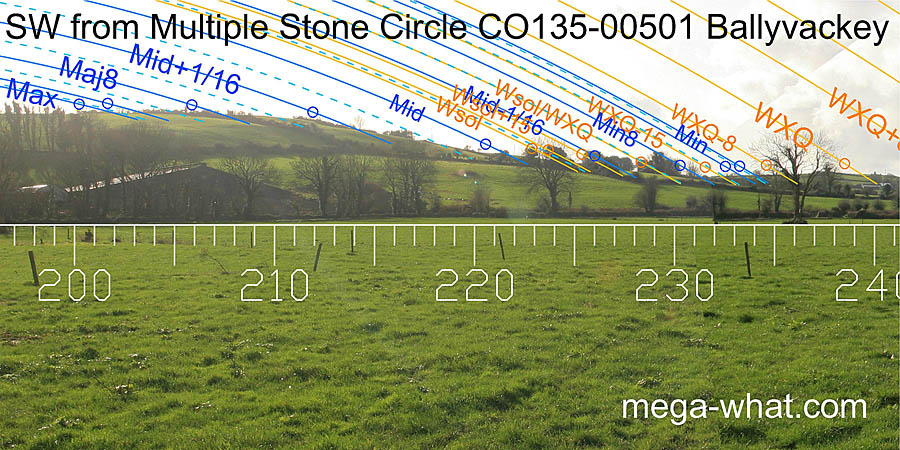 The next high point southwards falls between the cross-quarter and the lunar minimum and the notch at its southern foot marks the lunar minor eighth.
The hilltop at the southern end of this horizon sector is at the major end of the lunistice cycle and the midpoint occurs at a break in the slope.
The next high point southwards falls between the cross-quarter and the lunar minimum and the notch at its southern foot marks the lunar minor eighth.
The hilltop at the southern end of this horizon sector is at the major end of the lunistice cycle and the midpoint occurs at a break in the slope.
 From the boulder-burial, the eqinoctial zone has lost its accuracy though the half-month south of the equinox is now on the hilltop rather than at its southern foot.
From the boulder-burial, the eqinoctial zone has lost its accuracy though the half-month south of the equinox is now on the hilltop rather than at its southern foot.
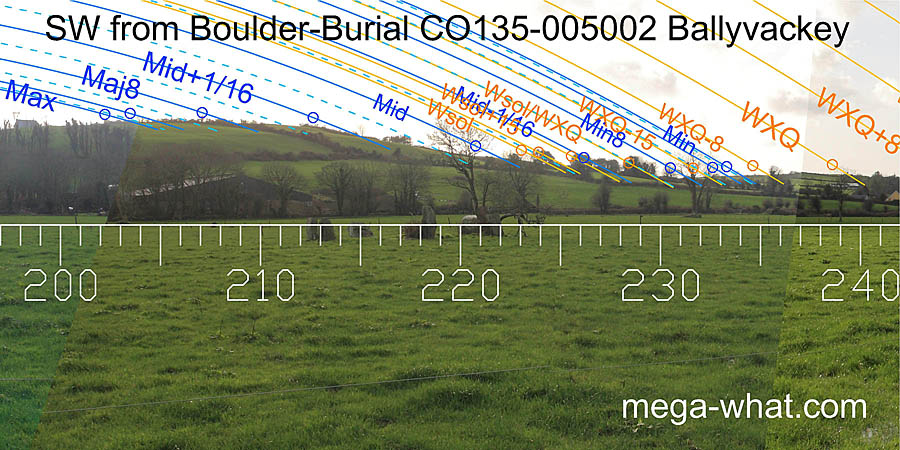 Again, from the boulder-burial, the lunar maximum remains essentially unchanged as does the lunar minor eighth.
The lunar midpoint is also in the same place but is now emphasised by being over the centre of the circle.
Again, from the boulder-burial, the lunar maximum remains essentially unchanged as does the lunar minor eighth.
The lunar midpoint is also in the same place but is now emphasised by being over the centre of the circle.
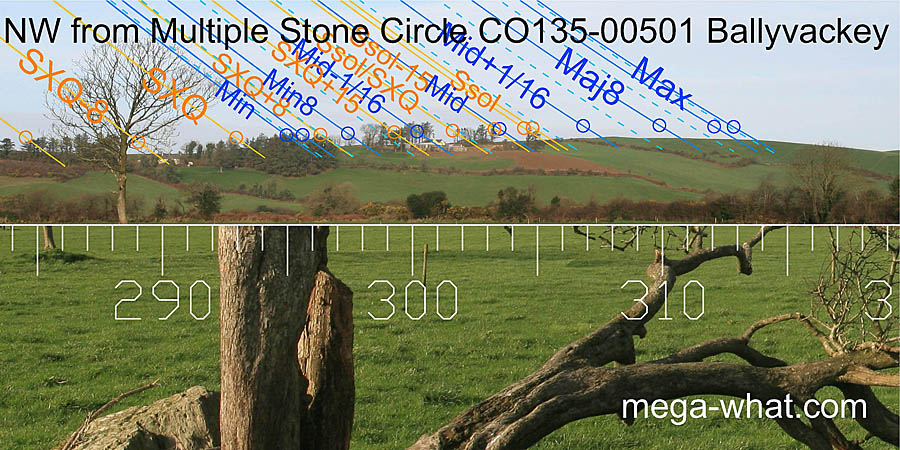 To the north-west, the first hilltop above the valley floor is halfway between the equinox and the summer cross-quarter.
Beyond that, survey has been complicated by trees, buildings and land reclamation but the sixteenth south of the lunar midpoint would seem to occur at a break in the slope.
The sixteenth north of the midpoint is on the first high point of the ridge and the lunar maximum falls on the last one.
Just out of sight over this horizon is Ahagilla multiple stone circle.
To the north-west, the first hilltop above the valley floor is halfway between the equinox and the summer cross-quarter.
Beyond that, survey has been complicated by trees, buildings and land reclamation but the sixteenth south of the lunar midpoint would seem to occur at a break in the slope.
The sixteenth north of the midpoint is on the first high point of the ridge and the lunar maximum falls on the last one.
Just out of sight over this horizon is Ahagilla multiple stone circle.
The circle is thus situated so that, to the west, the lunar maxima both north and south are on hilltops, with the equinox at the lowest point between them.
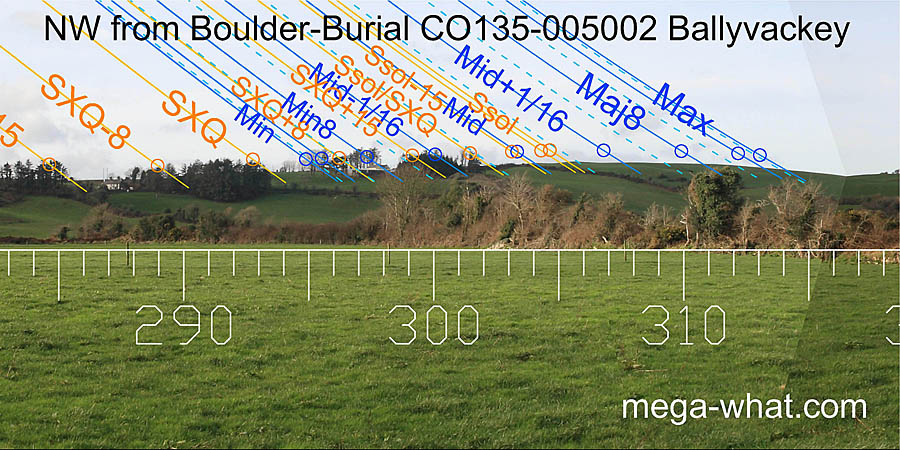 From the boulder-burial, the three significant markers to the north-west have been transposed into the lunar minor eighth, summer solstice and major eighth.
From the boulder-burial, the three significant markers to the north-west have been transposed into the lunar minor eighth, summer solstice and major eighth.
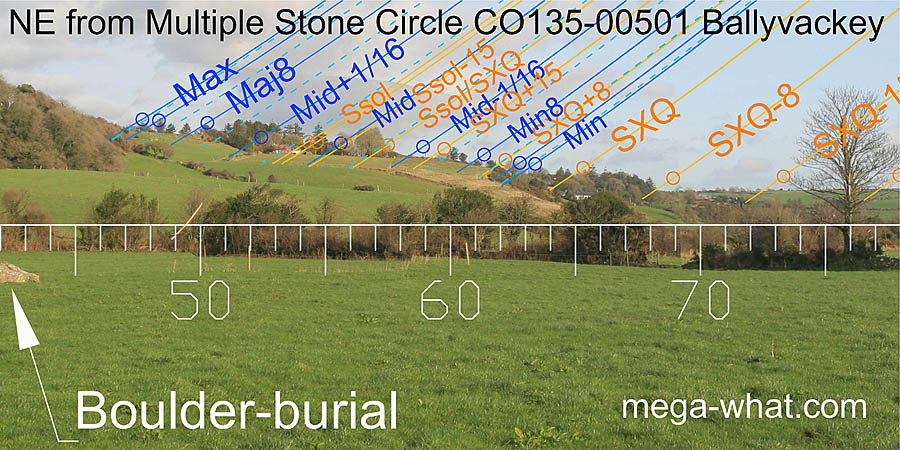 Accurate survey of the north-east is now impossible as the key points are occupied by buildings and trees.
The upper one seems to be a little beyond the summer solstice position, at the sixteenth on the major side of the lunar midpoint while the
lower one seems to have a double step that matches the lunar minimum and the summer cross-quarter.
Accurate survey of the north-east is now impossible as the key points are occupied by buildings and trees.
The upper one seems to be a little beyond the summer solstice position, at the sixteenth on the major side of the lunar midpoint while the
lower one seems to have a double step that matches the lunar minimum and the summer cross-quarter.
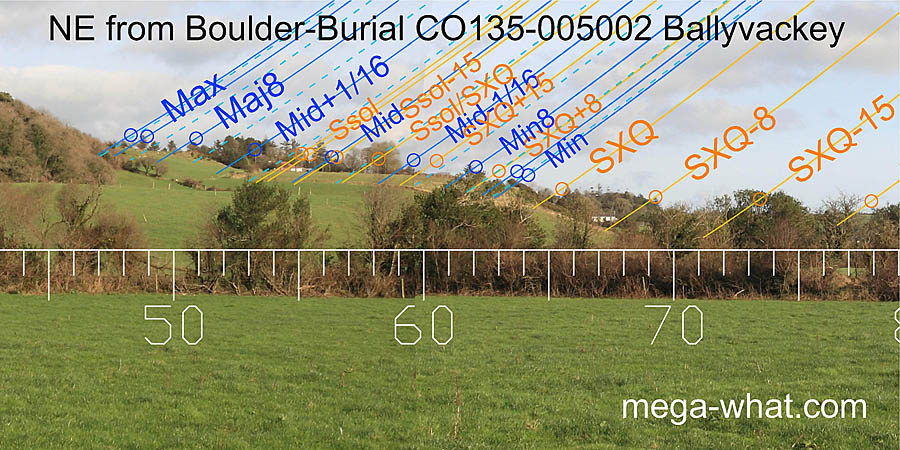 The north-east, like the south-west shows very little difference between the positions of circle and boulder-burial because the two monuments are only 50m apart on a north-east/south-west axis.
In contrast, declination values of horizon points in other directions are markedly different.
The north-east, like the south-west shows very little difference between the positions of circle and boulder-burial because the two monuments are only 50m apart on a north-east/south-west axis.
In contrast, declination values of horizon points in other directions are markedly different.
The eastern axis of the circle [closeup]
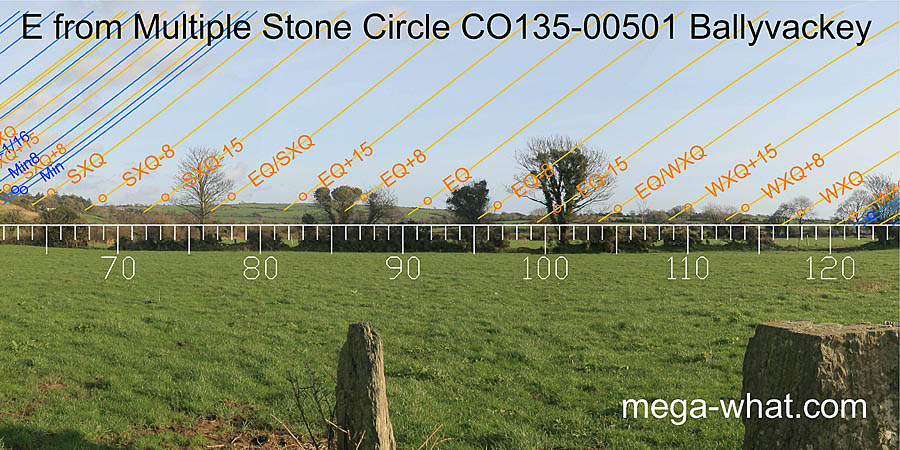 The eastern horizon is fairly distant and lacking in prominent features while survey is complicated by nearer hedges and trees.
To the south-east, a hilltop marks the half-month north of the winter cross-quarters.
North of that, the half-month south of the equinox is in a dip and the half-month north of it is on the next hilltop.
The eastern horizon is fairly distant and lacking in prominent features while survey is complicated by nearer hedges and trees.
To the south-east, a hilltop marks the half-month north of the winter cross-quarters.
North of that, the half-month south of the equinox is in a dip and the half-month north of it is on the next hilltop.
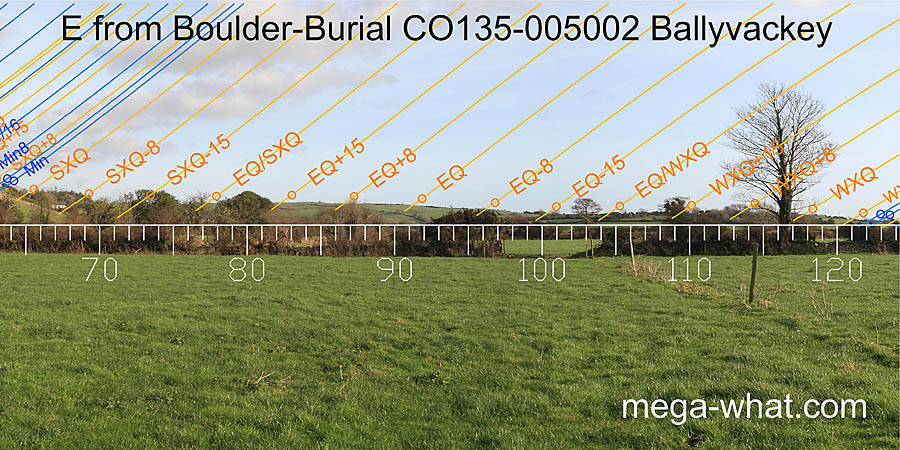 From the boulder-burial, the same south-eastern hilltop is a quarter-month rather than a half-month north of the cross-quarter but changes to the equinoctial zone are only slight.
From the boulder-burial, the same south-eastern hilltop is a quarter-month rather than a half-month north of the cross-quarter but changes to the equinoctial zone are only slight.
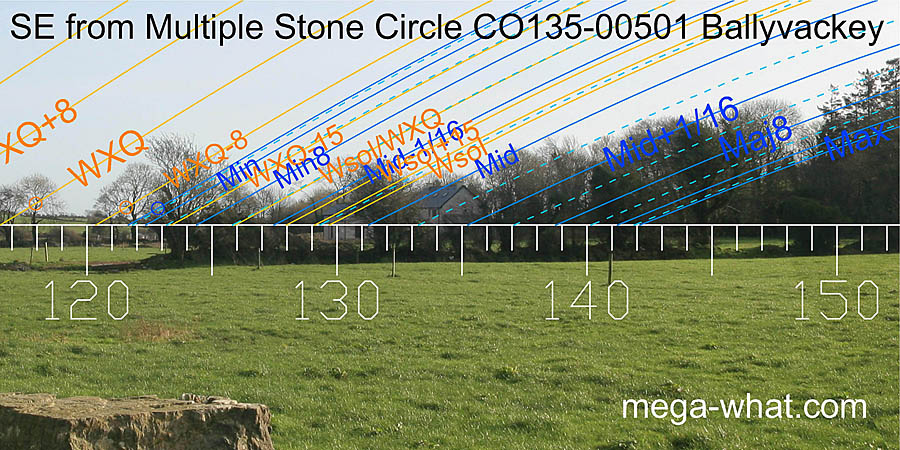 From both sites, the far south-east is unsurveyable due to trees but clearly there is a dip and then a rising local hillslope.
The axis of the boulder indicates an azimuth of about 166°, and a declination perhaps somewhere around -32° or -33°.
From both sites, the far south-east is unsurveyable due to trees but clearly there is a dip and then a rising local hillslope.
The axis of the boulder indicates an azimuth of about 166°, and a declination perhaps somewhere around -32° or -33°.
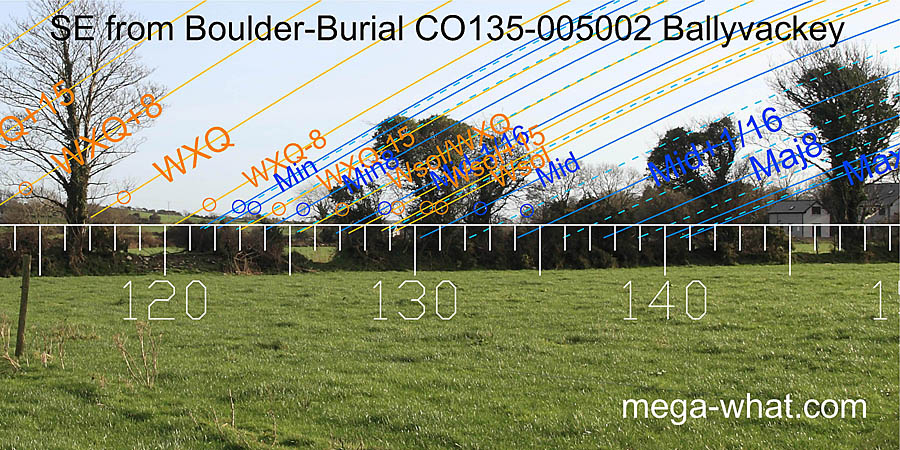 The location of the boulder-burial offers some useful markers not obtainable from the circle but it is not obvious which is the better site overall.
The location of the boulder-burial offers some useful markers not obtainable from the circle but it is not obvious which is the better site overall.
- There is one multiple stone circle to the east of this one, at Templebryan, 4.6km away at 76°.
- The nearest Boulder-Burial is at Letter, 2.5km to the north-north-east but it is unsurveyed.
- A surveyed boulder-burial-like "Megalithic Structure" is 4.3km to the south-south-east at Gortnascarty.
- Coolcraheen Standing Stone, from where another standing stone is in a significant position on the horizon, is 4.6km south-west (235°)
References
- Archaeological Survey of Ireland, record details. www.archaeology.ie/archaeological-survey-ireland
- O'BRIEN, WILLIAM 1992 Boulder-Burials: A Later Bronze Age Megalith Tradition in South-West Ireland. Journal of the Cork Historical and Archaeological Society 9:11-35.
- Ó'NUALLÁIN, SEÁN 1975 The Stone Circle Complex of Cork and Kerry. Journal of the Royal Society of Antiquaries of Ireland 105:83-131, No.3.
- Ó'NUALLÁIN, SEÁN 1984 A Survey of Stone Circles in Cork and Kerry. Proceedings of the Royal Irish Academy 84c:1-77, p23, no.35.
- POWER, D. et al. 1992 Archaeological Inventory of County Cork, Volume 1: West Cork. Dublin: Stationary Office. p20:no.43, p29:no.99, p46:no.242.
- RUGGLES, C.L.N. 1999 Astronomy in Prehistoric Britain and Ireland. Newhaven & London: Yale University Press. No.ASC47.
- RUGGLES, C.L.N. & PRENDERGAST, F. 1996 A New Archaeoastronomical Investigation of the Irish Axial-Stone Circles. Proceedings of the 2nd SEAC [European Society for Astronomy in Culture] Conference, Bochum, 1994. Bochum: Astronomisches Institut der Ruhr-Universität. pp5-13.
